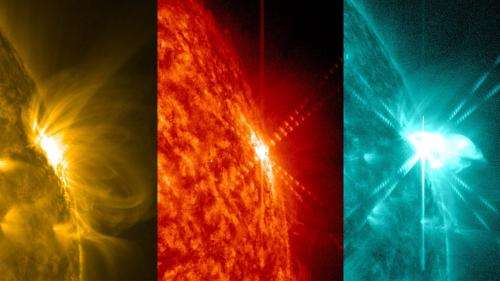Mid-level solar flare seen by NASA's SDO

The sun emitted a mid-level solar flare, peaking at 6:34 p.m. EDT on March 12, 2014, and NASA's Solar Dynamics Observatory, or SDO, captured an image of it. Solar flares are powerful bursts of radiation. Harmful radiation from a flare cannot pass through Earth's atmosphere to physically affect humans on the ground, however鈥攚hen intense enough鈥攖hey can disturb the atmosphere in the layer where GPS and communications signals travel.
To see how this event may impact Earth, please visit NOAA's Space Weather Prediction Center at , the U.S. government's official source for space weather forecasts, alerts, watches and warnings.
This flare is classified as an M9.3 flare, just slightly weaker than the most intense flares, which are labeled X-class. The letters denote broad categories of strength, while the numbers provide more information. An M2 is twice as intense as an M1, an M3 is three times as intense, etc.
This M9.3 flare was emitted by an active region鈥攁 magnetically strong and complex region on the sun's surface鈥攍abeled AR 11996.
Updates will be provided as they are available on the flare and whether there was an associated coronal mass ejection, or CME, another solar phenomenon that can send solar particles into space and affect electronic systems in satellites and on Earth.
Provided by NASA's Goddard Space Flight Center




















